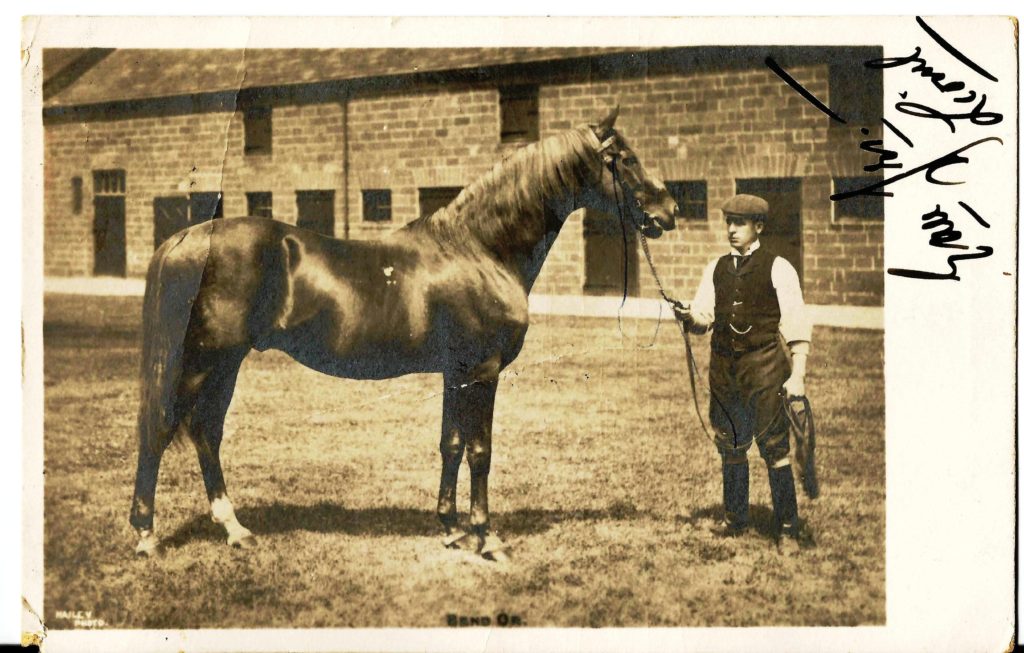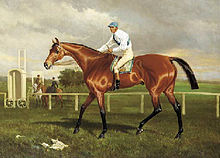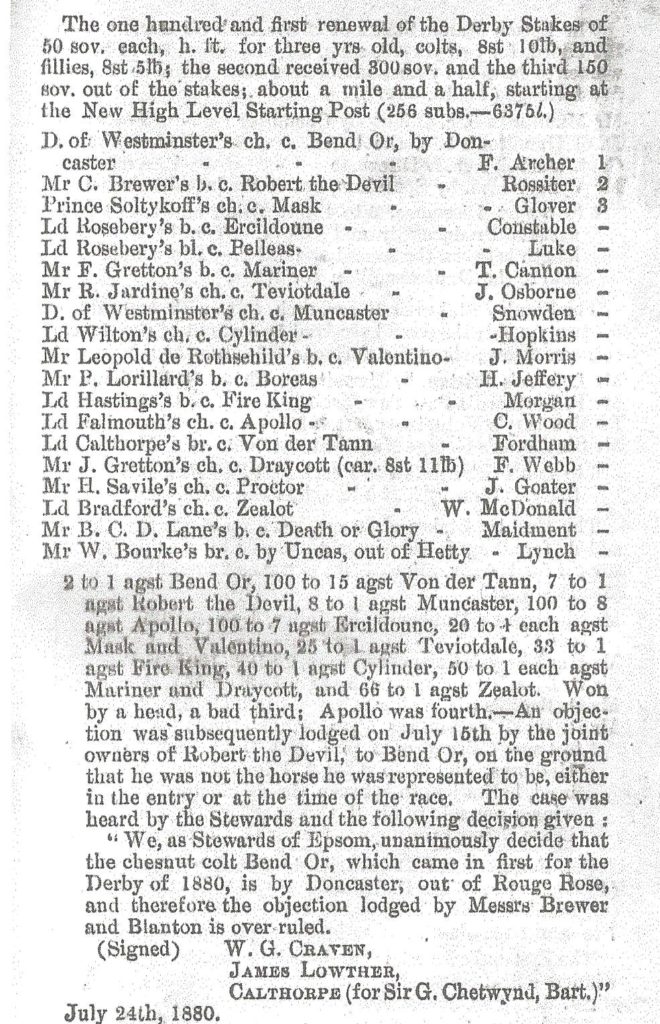The Prince & the Pauper
Bend Or & Robert the Devil
This is the tale of two great horses who vied for supremacy in the seasons 1880-81.
The Prince – Bend Or, was bred by Hugh Lupus Grosvenor, 1st Duke of Westminster, at his Eaton Stud in Chester, with a Classic pedigree. His sire, Doncaster, won the Derby in 1873 and his dam, Rouge Rose, was a daughter of the 1860 Derby winner, Thormanby.
The pauper – Robert the Devil, bred by Charles Brewer, was by the sprinter, Bertram (1872 King Stand Stakes), out of the apply named, Cast Off, by The Promised Land (1862 2,000 Guineas). Cast Off had been barren for many years before mated with Bertram and was left on the Cambridgeshire Fens at Wickham to fend for herself, until Robert the Devil was foaled.
Bend Or, a chestnut with a white blaze on his face, later stood 16.1 hands with a girth of 74 inches.
As a two-year-old he was unbeaten in five races, including the Richmond Stakes at Goodwood and the Prince of Wales’s Stakes at York.

A postcard of Bend Or at stud
Meantime, Robert the Devil, a “slashing” bay horse of 16.2 h.h. had won both his starts as a juvenile, including the valuable Rous Memorial Stakes at Goodwood.
The following year, Robert the Devil, starting at odds-on, was beaten a head in the Biennial Stakes at Newmarket, while Bend Or, not entered in the Guineas, waited for Epsom.

Robert the Devil – the slashing adversary
Bend Or’s Derby in 1880, was regarded as the race of the century, albeit in the run-up to the race, the favourite’s connections suffered great anxiety. First, Bend Or developed sore shins, which had to be treated day and night. Secondly, Fred Archer, booked to ride the colt, was badly savaged by the four-year-old Muley Edris and put on weight whilst under treatment for badly torn arm muscles, scaling 14lb overweight four days before the Derby. However, all the problems were resolved in the nick of time. Archer had a saddle made weighing only a pound and on the day with the help of a purgative known as “Archer’s mixture,” weighed in at the required 8st 10lb.
In a field of 19, Bend Or went off the 2-1 favourite, his chief opponents being Von der Tann, winner of the Bibury Club Champagne Stakes, on 100-15 and Robert the Devil on 7-1. The latter, ridden by Edward Rossiter took up the running at the top of the hill from Teviotdale and Mask. Around Tattenham Corner,
Archer, in a drive to gain the rails position, had to raise his left foot level with Bend Or’s head to prevent crushing it against the rails. His determination saw him through and he made up ground on Robert the Devil to the distance. At this point, although well clear, Rossiter looked back to see Archer bearing down on him with every stride, and immediately appeared to lose his nerve, until the two colts passed the post together. After an agonising wait, the number 7 was displayed on the Stewards Stand, indicating Bend Or was the winner. Twelve lengths behind, Mask finished a bad third.
On July 15, Charles Brewer, the popular bookmaker, who owned Robert the Devil in partnership with his trainer Charles Blanton, wrote to the Epsom stewards objecting to Bend Or on the grounds he “was not the horse which he was represented to be, either in the entry or at the time of the race”. Their information was that Bend Or and Tadcaster (by Doncaster out of Clemence, by Newminster) had been mixed up in their journey from Eaton to Newmarket and from Newmarket to Robert Peck’s stables in Russley, Wiltshire.
As expected the popular press got involved and described it as “The biggest racing scandal since the Running Rein affair in 1844.”

On July 24, after lengthy deliberation, as recorded above, the stewards announced:
“We, as Stewards of Epsom, unanimously decide that the chestnut colt, Bend Or, which came in first in the Derby of 1880, is by Doncaster out of Rouge Rose, and, therefore, the objection lodged by Messrs. Brewer and Blanton is overruled.”
In later years, however, one of the stewards, James Lowther, revealed that addition facts had come to his knowledge that had led him to doubt their decision.
Then in 1914, after a series of articles in Horse & Hound and the Bloodstock Breeders Review, several pieces of evidence came to light that supported the stewards’ decision, as Tony Morris later reported in the Thoroughbred Owner & Breeder.
“Bend Or had very round hoofs, a characteristic common in the family from which Rouge Rose descended. A lot of Bend Or’s stock were crib-biters, a vice for which Rouge Rose was herself notorious. And the Russley blacksmith reported that Bend Or and the other produce of Rouge Rose were always easy to shoe; Tadcaster would not allow him near his hind feet and others out of Clemence were the same. Besides, although both colts were chestnut, Bend Or was of the golden type with black spots, Tadcaster of the red variety and with lop-ears. There could be no mistaking them.”
Morris continued, “An interesting fact that drew no comment in the 1914 debate was that in 1882 Clemence was covered by Bend Or. It is hard to imagine that the Duke of Westminster would have sanctioned that mating, if he believed Clemence was Bend Or’s dam.”
The Bloodstock Breeders Review finally concluded, “There is little likelihood of any further light being thrown on the dispute.”
Eleven days after the Derby, Robert the Devil travelled to France to win the Grand Prix de Paris. He then followed up with victories in the St Leger, connections winning £80,000 in bets, the Cesarewitch and Champion Stakes, adding the Ascot Gold Cup and the Alexandra Plate as a four-year-old.
Bend Or went to Ascot to win the St James’s Palace Stakes, then ran unplaced in the St Leger behind Robert the Devil. He was then beaten a head by Robert the Devil in Newmarket’s Great Foal Stakes and slaughtered by him in the Champion Stakes, when going down by 10 lengths.
The following year, a revitalised Bend Or, returned to Epsom to win the City and Suburban Handicap, carrying the top weight of 9st. 0lb, from 23 rivals.
The final encounter of Bend Or and Robert the Devil took place in the Epsom Gold Cup (forerunner of the Coronation Cup), where the pair having deterred all opposition, ran a match. And although odds of 4-6 were laid on Robert, after a thrilling dual, Bend Or beat his arch-rival by a neck.
Bend Or ran twice more, winning the Champion Stakes from Scobell and Iroquois, then finally, in the Cambridgeshire, under Fred Archer and 9st 8lb, he gave way after a brave run.
After dominating the racing scene for two years the Pauper beat the Prince by three races to two. However, in Bend Or’s defence, his victory’s in the Derby and Epsom Gold Cup were each heralded as the race of the year.
Bend Or retired to stud at Eaton at a fee of 50 guineas and in his first crop got Ormonde (b.c. 1883), winner of the Triple Crown and Kendal (ch.c. 1883), the Champion Sire of 1897, through the efforts of his Triple Crown winner Galtee More. Unbelievably, the victory’s of Ormonde were not enough to make Bend Or the Champion Sire of 1886. His total stakes won of £22,803, were just £14 short of Hermit’s, who became Champion Sire for the seventh time. Bend Or died on 10 January 1903, aged 26.
By contrast, Robert the Devil failed to produce a notable offspring and died of an abdominal malady in 1889. After his death, he was prepared by a taxidermist and remains on show at Gibson’s Saddlery in Newmarket.
As a surprise postscript to this story, a recent DNA comparison of Bend Or to the Tadcaster family, continued the investigation, as Tony Morris reported in the Thoroughbred Owner & Breeder.
“A team led by Mim Bower at Cambridge University got to work on the skeleton of Bend Or, long preserved in the Natural History Museum, to discover whether he came from the No. 1 family to which Rouge Rose belonged or the No. 2 family of Clemence. It’s time to re-write a million pedigrees! The skeleton’s mitochondrial DNA proved characteristic of the No. 2 family, the assumption being he was the son of Clemence. He could not have been out of Rouge Rose, despite all that circumstantial evidence.”
And so, we are to believe that if the Epsom Stewards of 1880 had miraculously been in possession of the DNA samples, Bend Or would have been disqualified as a fraudulent entry and Robert the Devil would have been awarded the Derby.
And so ends a turf Tale of the Unexpected.